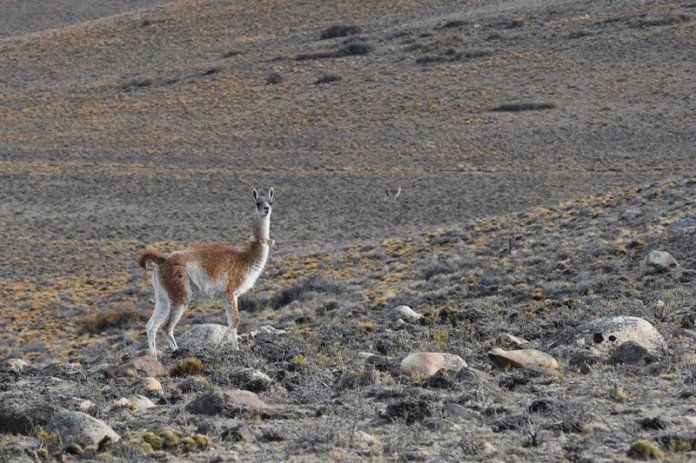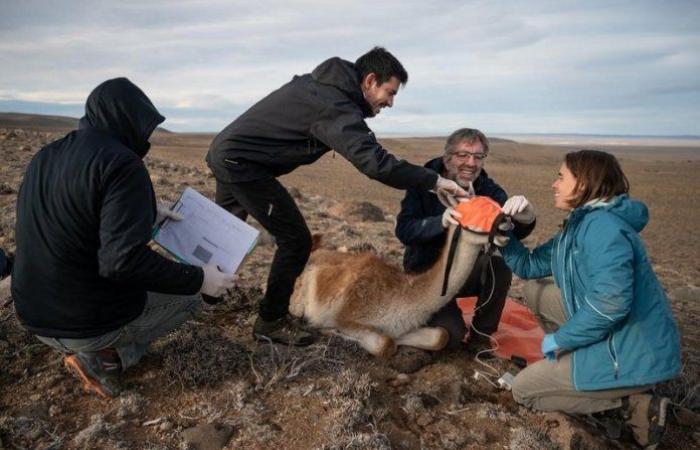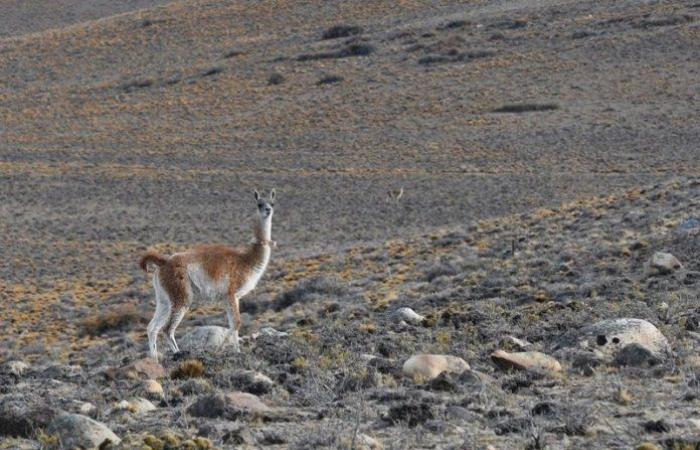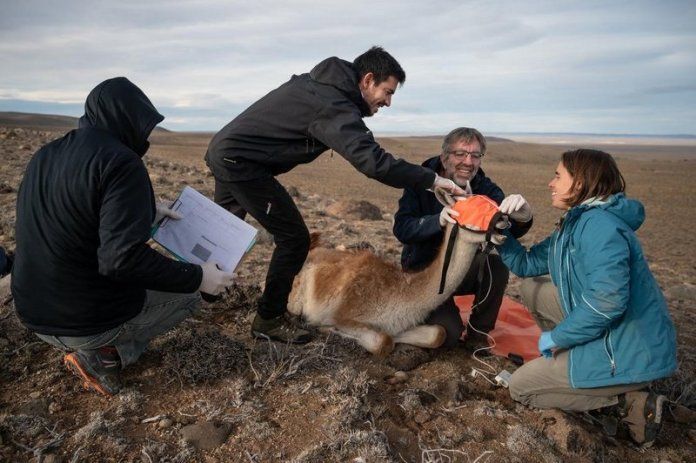And the vice president of the International Camel Organization for South America documented it
Photography – Franco Bott Yesh: Daniel Uribe, Vice President of the International Camel Organization in South America, documented the migration journey of “guanaco” – a species of camel – when the climatic conditions in the “Patagonia” desert were getting worse and escaping from its bitter winter.
He said, “When the climatic conditions worsen and become harder on the environment and their surroundings in the Patagonian desert, the animals, the most famous of which are guanacores, can only find a decision to migrate. It means continuing to survive. “
He added, “The Patagonian desert is one of the largest deserts in the world, and it occupies the fifth place among the largest, with an area of about 670 thousand square kilometers, most of which are located in Argentina and part of it in Chile.”
And about that trip, said Daniel Uribe, in the ICO South America: It is “a journey fraught with dangers, and the situation requires that all those interested in camel and wildlife affairs should think about providing protection, especially in the migration routes of guanaco.”
Urii’s call for the need to think about protecting these famous animals came after a group of 100 guanaco animals were seen at the foot of the Lake Buenos Aires plateau, fleeing the consequences of the harsh Patagonia winter, after a long journey in search of life, after the cover was damaged Vegetarianism from dense snow and frost, for fear of melting ice with warming temperatures; This prompted these animals to decide to search for higher areas by climbing the White Plateau.
Uribe confirmed that the “guanaco” animal flight gave indications of its success after the arrival of the first batch to the foot of the plateau. Where they began in September to ascend to their destination after a full 9 hours of walking during which they traveled 30 kilometers, and thus this group is the first this year that has succeeded in climbing the White Plateau to escape the consequences of the harsh “Patagonia” winter.
The “Patagonia” desert is bordered to the west by the Andes and the Pacific Ocean, factors that made its weather hot in summer and extremely cold in winter. Where the temperature reaches 40 degrees Celsius in summer, and with lower degrees ranging between 12 and 3 degrees Celsius in winter, vegetation cover is severely affected, or at least its density decreases; This forces guanaco to decide to migrate.
With the aftermath of the “Patagonia” winter, it became customary every year to see “guanaco” groups on their journey to life, in search of safer areas and more abundant in food and vegetation, and these animals have no choice but to climb the plateau of Lake Buenos Aires.
It is worth noting that the International Camel Organization (ICO) is a non-profit organization based in Riyadh, founded by Fahd bin Hathleen in March 2019, and it currently includes 105 member states on the level of the six continents of the world, and aims to develop and serve everything related to camels as a heritage and global culture.



International Camel Organization
Zaid Al-Khmashi
Previously
2020-10-09
Photography – Franco Bott Yesh: Daniel Uribe, Vice President of the International Camel Organization in South America, documented the migration journey of “guanaco” – a species of camel – when the weather conditions in the “Patagonia” desert were getting worse and escaping from its bitter winter.
He said, “When the climatic conditions worsen and become harder on the environment and their surroundings in the Patagonian desert, the animals, the most famous of which are guanacores, can only find a decision to migrate. It means continuing to survive. “
He added, “The Patagonian desert is one of the largest deserts in the world, and it occupies the fifth place among the largest, with an area of about 670 thousand square kilometers, most of which are located in Argentina and part of it in Chile.”
And about that trip, said Daniel Uribe, in the ICO South America: It is “a journey fraught with dangers, and the situation requires that all those interested in camel and wildlife affairs should think about providing protection, especially in the migration routes of guanaco.”
Urii’s call for the need to think about protecting these famous animals came after a group of 100 guanaco animals were seen at the foot of the Lake Buenos Aires plateau, fleeing the consequences of the harsh Patagonia winter, after a long journey in search of life, after the cover was damaged Vegetarianism from dense snow and frost, for fear of melting ice with high temperatures; This prompted these animals to decide to search for higher areas by climbing the White Plateau.
Uribe confirmed that the “guanaco” animal flight gave indications of its success after the arrival of the first batch to the foot of the plateau. Where they began in September to ascend to their destination after a full 9 hours of walking during which they traveled 30 kilometers, and thus this group is the first this year that has succeeded in climbing the White Plateau to escape the consequences of the harsh “Patagonia” winter.
The “Patagonia” desert is bordered to the west by the Andes and the Pacific Ocean, factors that made its weather hot in summer and extremely cold in winter. Where the temperature reaches 40 degrees Celsius in summer, and with lower degrees ranging between 12 and 3 degrees Celsius in winter, vegetation cover is severely affected, or at least its density decreases; This forces guanaco to decide to migrate.
With the aftermath of the “Patagonia” winter, it became customary every year to see “guanaco” groups on their journey to life, in search of safer areas and more abundant in food and vegetation, and these animals have no choice but to climb the plateau of Lake Buenos Aires.
It is worth noting that the International Camel Organization (ICO) is a non-profit organization based in Riyadh, founded by Fahd bin Hathleen in March 2019, and it currently includes 105 member states on the level of the six continents of the world, and aims to develop and serve everything related to camels as a heritage and global culture.
09:41 PM
Documented by the Vice President of the International Camel Organization for South America

Photography – Franco Bott Yesh: Daniel Uribe, Vice President of the International Camel Organization in South America, documented the migration journey of “guanaco” – a species of camel – when the weather conditions in the “Patagonia” desert were getting worse and escaping from its bitter winter.
He said, “When the climatic conditions worsen and become harder on the environment and their surroundings in the Patagonian Desert, the animals, the most famous of which are guanacores, can only find a decision to migrate, which is an annual decision that has a deadline and a specific time for its implementation. The guanaco realizes that escaping from the harsh and harsh Patagonian winter It means continuing to survive. “
He added, “The Patagonian desert is one of the largest deserts in the world, and it occupies the fifth place among the largest, with an area of about 670 thousand square kilometers, most of which are located in Argentina and part of it in Chile.”
And about that trip, said Daniel Uribe, in the ICO South America: It is “a journey fraught with dangers, and the situation requires that all those interested in camel and wildlife affairs should think about providing protection, especially in the migration routes of guanaco.”
Urii’s call for the need to think about protecting these famous animals came after a group of 100 guanaco animals were seen at the foot of the Lake Buenos Aires plateau, fleeing the consequences of the harsh Patagonian winter, after a long journey in search of life, after the cover was damaged Vegetarianism from dense snow and frost, for fear of melting ice with warming temperatures; This prompted these animals to decide to search for higher areas by climbing the White Plateau.
Uribe confirmed that the “guanaco” animal flight gave indications of its success after the arrival of the first batch to the foot of the plateau. Where they began in September to ascend to their destination after a full 9 hours of walking during which they traveled 30 kilometers, and thus this group is the first this year that has succeeded in climbing the White Plateau to escape the consequences of the harsh “Patagonia” winter.
The “Patagonia” desert is bordered to the west by the Andes and the Pacific Ocean, factors that made its weather hot in summer and extremely cold in winter. Where the temperature reaches 40 degrees Celsius in summer, and with lower degrees ranging between 12 and 3 degrees Celsius in winter, vegetation cover is severely affected, or at least its density decreases; This forces guanaco to decide to migrate.
With the consequences of the “Patagonia” winter, it became customary every year to see “guanaco” groups on their journey to life, in search of safer areas and more abundant food and vegetation, and these animals have no choice but to climb the plateau of Lake Buenos Aires.
It is worth noting that the International Camel Organization (ICO) is a non-profit organization based in Riyadh, founded by Fahd bin Hathleen in March 2019, and currently includes 105 member states on the level of the six continents of the world, and aims to develop and serve everything related to camels as a heritage and global culture.
These were the details of the news Watch … the migration journey of 100 camelids towards the “White... for this day. We hope that we have succeeded by giving you the full details and information. To follow all our news, you can subscribe to the alerts system or to one of our different systems to provide you with all that is new.
It is also worth noting that the original news has been published and is available at saudi24news and the editorial team at AlKhaleej Today has confirmed it and it has been modified, and it may have been completely transferred or quoted from it and you can read and follow this news from its main source.







